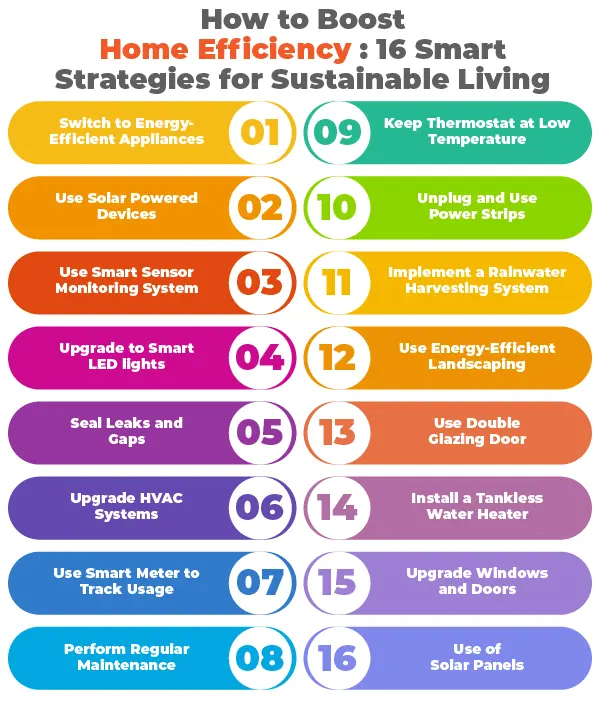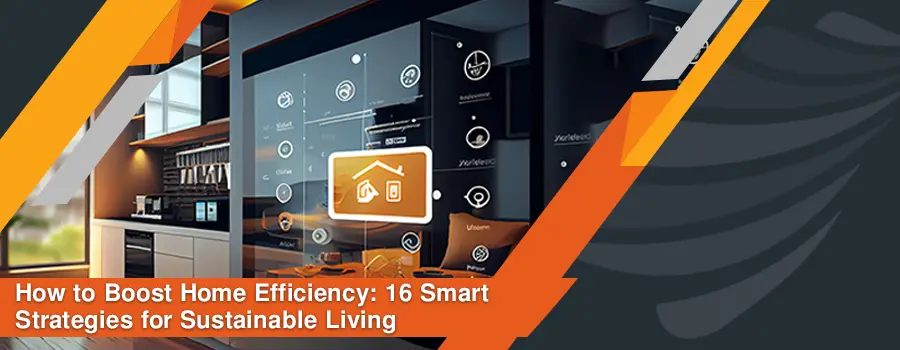Imagine the joy of waking up in a home that enhances your quality of life and nurtures the environment. As the morning sun filters through your energy-efficient windows, your room is warmed to the right temperature. Stepping into your kitchen, you’re greeted by a comfortable environment, thanks to your smart thermostat adjusting the temperature to perfection upon your entrance.
Contrary to popular belief, creating an energy-efficient home is simple. You can transform your living space into an energy-saving haven with a few simple changes. You can make a significant difference by installing a single energy-efficient system, using energy-efficient light bulbs, and adopting Internet of Things (IoT) solutions. We’re here to guide you through these 16 smart strategies for sustainable living and home efficiency, empowering you to create a home that’s both efficient and environmentally friendly.

1. Switch to Energy-Efficient Appliances
Electrical appliances in a home are significant contributors to energy consumption, accounting for around 20% of the average household’s electricity bill. However, the good news is that replacing old appliances with energy-efficient models can significantly reduce this burden. These appliances not only use less energy to perform the same task, but they also bring tangible benefits to your life. They reduce your electricity bill, and importantly, lessen your environmental impact. Even more, they come with the assurance of Energy Star labels, signifying their adherence to strict energy efficiency guidelines. It’s a win-win situation for your pocket and the planet, and a step towards a more sustainable future.
2. Use Solar Powered Devices
Using solar-powered devices at home is not just a great way to harness renewable energy, but also a responsible choice for the environment. These devices, ranging from phone chargers and outdoor lights to kitchen gadgets, are a testament to the power of individual actions. By using solar energy, you’re not just reducing your reliance on grids and your bills, but you’re also making a significant contribution to our collective effort to protect the planet. Every small step counts, and together, we can make a significant difference in preserving our environment for future generations.
3. Use Smart Sensor Monitoring System
Smart sensor monitoring and management systems like HIVE allow you to control your home appliances via your smartphones. You can monitor your energy usage, control devices, and set schedules remotely. The system helps you to manage your home’s energy efficiency effortlessly and ensures appliances are only used when needed. Also, you can monitor sensor health and easily get notified if there is a need to repair or change, making it easy to manage smart devices and ensure sustainability.
4. Upgrade to Smart LED lights
Replace all the lights in your house with LED bulbs to reduce energy use and electricity costs. Smart LED lights are stylish, affordable, and more efficient than halogen bulbs. They also have a far longer lifespan and consume up to 75% less energy than conventional incandescent lamps.
5. Seal Leaks and Gaps
Proper insulation and sealing leaks and gaps in your home help reduce energy loss. Insulate your walls, floors, and attic. Seal cracks and gaps around doors and windows to prevent drafts. You can use caulk and weatherstripping to seal these areas. This helps maintain a consistent indoor temperature, reducing the need for continuous heating or cooling.
6. Upgrade HVAC Systems
HVAC refers to systems that include heating, ventilation, and air conditioning. These systems, including heat pumps, air conditioners, furnaces, ductwork, thermostats, and other home comfort controls, oversee your house’s heating and cooling. Consider replacing outdated HVAC (heating, ventilation, and air conditioning) systems with energy-efficient ones. Properly maintaining current systems helps increase efficiency.
7. Use Smart Meter to Track Usage
A smart meter is a digital gadget that tracks the energy used in your house in real-time and gives you comprehensive information about your usage habits. By installing a smart meter, you can monitor your energy consumption throughout the day and determine periods of peak demand. With this information, you can decide when to use appliances and move energy-intensive jobs to off-peak hours to reduce your energy usage. Additionally, smart meters assist in identifying energy waste so that you can address it and raise the general efficiency of your house.
8. Perform Regular Maintenance
Frequent maintenance improves HVAC system performance and reduces energy use. This includes cleaning filters, monitoring refrigerant levels, and ensuring insulation is in place. Numerous advantages of routine maintenance have a good impact on energy efficiency. Equipment performance can be optimized, leading to significant energy savings, by performing routine inspections, cleaning, and tunings. Systems that are kept up to date run more smoothly and use less energy to do their intended tasks. As a result, there is less energy waste, less money spent on utilities, and less carbon footprint.
Furthermore, routine maintenance extends the equipment’s lifespan, minimizing the need for premature replacements. This can save money and lessen the environmental damage of producing new machinery.
9. Keep Thermostat at Low Temperature
The Energy Department advises keeping the thermostat between 68 and 70 degrees Fahrenheit when awake. Lower the temperature to the suggested 7 to 10 degrees when sleeping or not home for extended periods. Heat loss occurs more slowly in winter when the inside temperature is lower. Because your home has lost less energy than it would have at the higher temperature, the longer it stays at the lower temperature, the greater the energy you save.
Installing smart thermostats lets you forget about adjusting. After learning your preferred temperature, they create a schedule that turns the heater on automatically at night or when you’re not home. Using geofencing, your smart thermostat can sense when you’re heading home and automatically set the temperature to your preferred level.
10. Unplug and Use Power Strips
Unplugging electronics while not in use is the simplest approach to prevent power outages. For instance, unplug their chargers when your portable devices aren’t charged. You can reduce your electricity usage by putting some electronics into power strips and shutting them off. An extra switch won’t help your basic lamp, but anything with a standby mode or a display that turns on when the device is off is worth considering. Power strips stop connected devices from using standby power and allow you to recognize when devices are in standby mode.
Power strips have a master switch that can be manually turned off when not in use. Their main benefit is plugging numerous devices into a single outlet. Surge protectors, which are usually a different feature, can be integrated into power strips. As a result, your linked electrical gadgets may become susceptible to power surges.
11. Implement a Rainwater Harvesting System
Collecting and storing rainwater instead of letting it flow off is known as rainwater harvesting, or RWH. Rainfall is gathered from a surface that resembles a roof and directed to a percolating tank, cistern, deep pit (well, shaft, or borehole), aquifer, or reservoir so that the water seeps down and replenishes the ground.
Depending on your system’s capabilities, you can use collected rainwater to flush toilets, wash automobiles, or even rinse. It is also a great water supply for landscape irrigation because it lacks minerals, dissolved salts, and contaminants.
Gathering and conserving rainwater for outdoor use may save money on water bills and protect a valuable natural resource. Households that install a rainwater harvesting system will see a 35% to 40% reduction in their water usage.
12. Use Energy-Efficient Landscaping
With thoughtful landscaping, your house’s efficiency can be increased. Planting trees can reduce the cost of heating and cooling in various climates and seasons. The U.S. Department of Energy claims that strategically placed trees can reduce energy expenses associated with heating and cooling by as much as 25%. The best location for shade trees can also reduce building insulation costs and heating and cooling expenses.
Some tree species offer seasonal benefits. For instance, adding vines or deciduous trees on the western side of a house or other structure might help keep it cool throughout the summer. You can also reduce your irrigation needs by adopting native plants that require less water.
13. Use Double Glazing Door
Double glazing traps air between the two levels. Since glass conducts heat well, heat moves through your windows naturally and doesn’t need to go through double glazing. However, because air is a poor heat conductor, the trapped air creates an insulating layer between the warm and cool air on either side.
Double glazing forms a barrier between your home’s interior and exterior, making it a crucial component of energy-efficient home design. By keeping warm air from leaving your home and preventing cold air from entering, double glazing helps reduce heat loss through windows, doors, and conservatories.
14. Install a Tankless Water Heater
Tankless water heaters heat water as needed, unlike conventional heaters that continuously heat and reheat water. As a result, standby energy loss is greatly decreased, which lowers energy consumption and, in turn, lowers energy expenses. “Demand (or tankless) water heaters can be 24% to 34% more energy efficient than conventional storage tank water heaters for homes that use 41 gallons or less of hot water daily,” said Energy.gov. The longer gas-fired tankless water heaters are used, the more money households save annually.
15. Upgrade Windows and Doors
Outdated doors and windows can be replaced with models with several glass layers, low-emissivity coatings, and low-conductivity gasses between the glass panes. A thermal break, or plastic insulator between the inner and outer portions of the frame, is a feature found on most modern glass doors with metal frames. Moreover, modern, energy-efficient windows and doors offer many benefits over their old-fashioned counterparts, including decreased heating and cooling expenses, translating into lower energy use and utility bills.
16. Use of Solar Panels
Solar panels harness the power of the sun to generate electricity at your home. The initial investment in solar panel installation can be huge, but it saves your energy bills in the long term. You can save more money with solar panels the more energy your system generates. A typical household solar system generates 350–850 kWh of electricity monthly. Considering that the average home uses 909 kWh of energy every month, solar energy can save up to 90% on monthly electric bills. Additionally, the government provides tax relaxations, incentives, and loans for solar panel installation to promote its reliance on residential areas.
Final Thoughts
Transforming your house into a sustainable, energy-efficient place helps reduce your carbon footprint and electricity bill, increase energy efficiency, and improve your comfort level. These suggested strategies show that little changes may have a significant impact because they are simple to implement and help create a more sustainable and greener future together. Take the first step toward a more eco-friendly and efficient home today and reap the results later.





